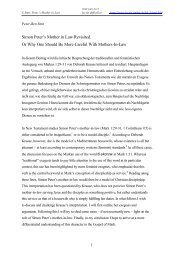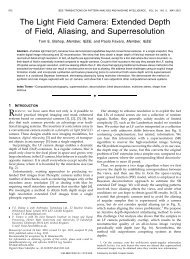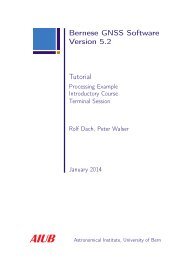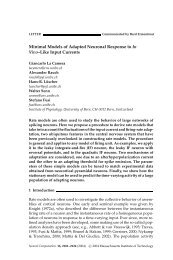Deploying Real-Life WSN Applications: Challenges ... - IAM - CDS
Deploying Real-Life WSN Applications: Challenges ... - IAM - CDS
Deploying Real-Life WSN Applications: Challenges ... - IAM - CDS
Create successful ePaper yourself
Turn your PDF publications into a flip-book with our unique Google optimized e-Paper software.
8 International Journal of Distributed Sensor Networks<br />
Setup Steady state Transmit<br />
P i (t)<br />
ADV<br />
JOIN<br />
TDMA<br />
···<br />
Frame<br />
(a)<br />
Round<br />
Setup<br />
Steady state<br />
RCV-SUC Transmit<br />
P i (t)<br />
ADV<br />
JOIN<br />
TDMA<br />
/SCH<br />
SCH<br />
···<br />
Frame<br />
Round<br />
(b)<br />
Figure 5: (a) Timeline of LEACH. (b) Timeline of the proposed protocol.<br />
the next hop nodes. Other INs execute the same algorithm<br />
recursively to discover the next hop nodes. This route<br />
discovery algorithm generates multiple disjoint paths to<br />
improve the reliability of data delivery.<br />
3.3.5. Other Nodes. The other nodes are in charge of basic<br />
works such as initialization, data sensing, cluster formation,<br />
and data transmission (within cluster). Normal nodes have<br />
minimal energy consumption than other categories.<br />
4. Performance Analysis<br />
In this section, we evaluated the performance of our proposed<br />
mechanism based on two factors: energy consumption<br />
and reliability. At first, we observed the energy dissipation<br />
amount of each category in one round and analyzed the<br />
cause in details. Then we analyzed the energy savings by<br />
using strategies of branch node energy conservation and<br />
flexible INs MAC protocol. We also compared the proposed<br />
mechanism with previous clustering based works [4, 5] on<br />
the performance of network lifetime, which is a synthesis<br />
factor to evaluate the superiority of wireless sensor networks.<br />
In the next we set different node failure rates and observed<br />
the average packet delivery ratios, which reflect the success<br />
rate of packet transmissions to the BS. We compared the<br />
situations of with/without SCHs and multipath routing<br />
algorithm, respectively. <strong>WSN</strong> reliability can be measured<br />
through this result.<br />
4.1. Experiment Setup. We have carried out a set of experiments<br />
using NS-2 simulator. In the simulation, we used the<br />
same radio energy dissipation model as in [4]. The values<br />
of parameters used for simulation are as shown in Table 2.<br />
Table 2: Simulation parameters.<br />
Parameters<br />
Value<br />
Topology size<br />
1000 m × 1000 m<br />
Number of nodes 1000<br />
Transmission range<br />
50 m<br />
Sensing range<br />
40 m<br />
Initial energy<br />
5 J<br />
Packet size<br />
4000 bits<br />
Location of BS (600, 160)<br />
Bandwidth<br />
1 Mb/s<br />
Electronics energy<br />
50 nJ/bit<br />
Free space ε fs 10 pJ/bit/m 2<br />
Multipath fading ε mp 0.0013 pJ/bit/m 4<br />
Average data aggregation energy<br />
5 nJ/bit/singal<br />
Percentage of CHs (%) 3, 4, 5<br />
In the following experiments, we set that the percentage<br />
of cluster head number 3%, 4%, and 5%, respectively. We<br />
evaluated the energy dissipation of different categories of<br />
nodes in one round and the reliability with two kinds<br />
of strategies. Every result shown is the average of 100∼<br />
200 experiments, and the confidence interval used in the<br />
simulation is 95%.<br />
4.2. Energy Dissipation. The first experiment we do is to<br />
obtain the average energy dissipation of different category<br />
of nodes in one round. Here we divided a round into four<br />
phases as illustrated in Figure 6, which is little different from<br />
the phases we divided in Section 3.2. We can observe that<br />
in each phase the energy dissipation of each kind of node

















